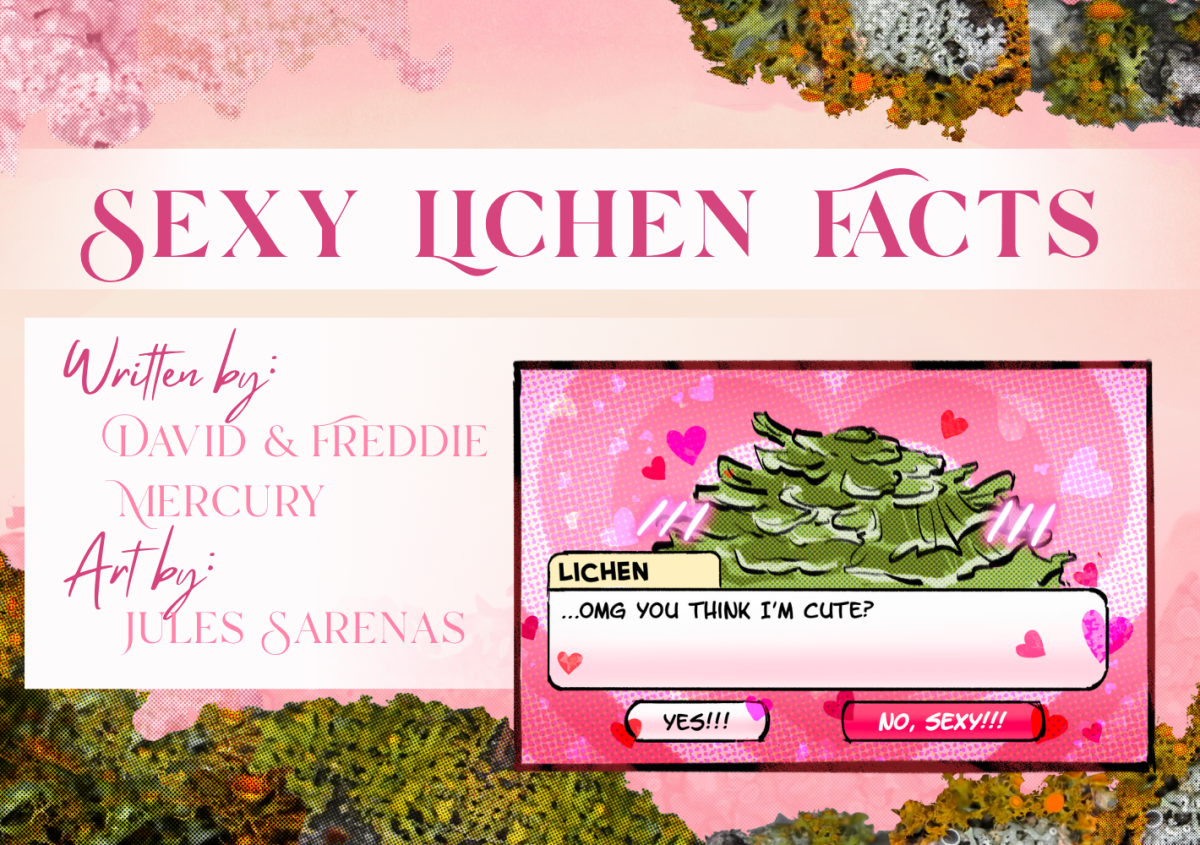
Jules Sarenas
Recently, my biology professor asked the class if any of us knew what lichen was. Surprisingly, I was the only person who raised my hand. While I am outraged by how few people know about lichen, I also recognize its advantages. As we enter the chillier uni mating season, here’s some cool and sexy lichen facts to impress that alt cutie in your physics lab.
“So what is lichen, anyways?”
So glad you asked. It’s super cool. Lichen is a symbiotic relationship between fungi, algae, cyanobacteria, and sometimes yeast. What’s crazy is that this survivalist polycule is composed of organisms in completely different kingdoms of life, but they still find a way to get it on (proof that there is literally nothing stopping you from hitting on that CS major who you think is out of your league — just put on some deodorant first). Teaming up allows these guys to survive extreme conditions — lichens have been found photosynthesizing at temps as low as -22ºF! Some have been found to live as long as 4500 years old! That’s the power of love — freaky lichen love!
Anatomy of a Lichen
All lichen thalli (which is Greek for shoot — bitches go wild for fancy words with Greek origins), are composed of layers. The top layer, composed of a matrix of fungal hyphae, shields the photosynthetic algae, cyanobacteria and yeast (stored in the aptly named algal layer) from dangerous UV radiation. The medulla is where the fungus synthesizes and stores substances that it uses to encourage its captives to photosynthesize at higher rates (many experts argue that this is parasitic behavior — I think it’s just kinky). Finally, the lower cortex anchors the whole thing to rocks, soil, or tree trunks with special root-like appendages called rhizines.
Lichens are categorized by the species of fungus that takes part in the relationship. This is because without the other constituents, it cannot survive (if this isn’t the perfect opposite of doomed yaoi, idk what is). Most lichen fungi hail from the phylum Ascomycota, or cup fungi. Ascus is Latin for cup (bitches go crazy for fancy words with Latin origins). They are also categorized this way because only the fungi can sexually reproduce.
Lichenous Love
You see, ascomycetes in general have four genders (checkmate, liberals) aptly numbered 1, 2, 3, and 4. 1mates with 3, and 2 mates with 4. I like to imagine them as the cute main characters in a romcom and their less cute sidekick counterparts. Or as Princess Peach & Mario, and Princess Daisy & Luigi. Anyway, the way this works is with a handshake. A really sexy handshake. You see, when two lichens, who might not know the other exists, sit next to each other, they may touch tips. The tips of their hyphae, known as gametangia, touch and exchange chemical signals — the lichen version of asking for pronouns.
This might be a good time to explain that asco-fungi can do some wild shit. Their cell walls have pores which allow them to willfully pass nuclei between them. So, when lichen buddies touch tips, they pass nuclei from the antheridium to the archegonium (lichen versions of top and bottom). From here, cells divide with two nuclei instead of one, passing these nuclei up into a structure called an apothecium (bitches go insane for lichen sex organs with fancy names). Within a lichen’s apothecia, the nuclei fuse and form spores, which are released into the wild, hoping to one day dominate a new culture of algae, cyanobacteria, and/or yeast.
Wild Lichen in The Wild (Wild!)
Now that you know what lichen is, and, more importantly, how it fucks, it’s time to point it out while on a date. There are three types of lichen:
Crustose lichen covers the surface like a flat, spongy crust. If you look closely, you can often see its apothecia along the top, especially after it rains. These guys are incredibly abundant all over campus.
Foliose lichen is arguably the peakest lichen. It looks like a wrinkly leaf, with a clearly defined topside and underside, and is often anchored to its substrate at multiple points along the ruffle.
Fruticose lichens are big and voluptuous, often having cylindrical or branching thalli. They are not to be confused with moss.
When pointing out lichen to a potential mate, remember to be casual and PLAY IT COOL. Your lover will recognize your scholarly and contemplative appreciation for nature, rather than seeing you as a huge lichen freak. If they’re freaked out anyways, it really wasn’t meant to be, and you should consider adjusting your taste because you’re obviously setting the bar too low.
Now, obviously, even when armed with foolproof sexy lichen facts, you still have to make the first move. Your author recommends releasing your spores of knowledge carefully but liberally (in fact, sexy lichen facts are primarily responsible for your author’s relationship status… and could be for yours as well). Be confident! Armed with this knowledge, may you pursue your most lichenous romance this fall!